Cwm yr Afon
| Alternative names | Drosgol [Dewey & Bromehead 1915: 51] (not to be confused with Drosgol manganese mine, Ponterwyd, Ceredigion) Foel Ddu |
||||||||||||||||||||||||||||||||||||||
|---|---|---|---|---|---|---|---|---|---|---|---|---|---|---|---|---|---|---|---|---|---|---|---|---|---|---|---|---|---|---|---|---|---|---|---|---|---|---|---|
| Location | SH640292 - SH643289 ? (Area map showing location.) | ||||||||||||||||||||||||||||||||||||||
| Parish | Llanbedr | ||||||||||||||||||||||||||||||||||||||
| Geology | The ore bed is about .38 m thick and consists of carbonate of manganese mixed with a small proportion of silicate. Analysis showed the ore to contain 35% manganese. [Dewey & Bromehead 1915: 51] | ||||||||||||||||||||||||||||||||||||||
| Owners |
|
||||||||||||||||||||||||||||||||||||||
| Worked | 1889–1891, c.1916–c.1923 | ||||||||||||||||||||||||||||||||||||||
| Production and Employment |
|
||||||||||||||||||||||||||||||||||||||
| Transport | Small cart to Cwm yr Afon farm (SH62363012) where the ore was transfered to larger carts for transport to Llanbedr [Smith 1997: 25]. | ||||||||||||||||||||||||||||||||||||||
| Remains | Extensive site with opencast workings, in parts substantial with large tips, and a number of underground workings, some of which have been backfilled with waste. A number of the workings, both surface and underground, have standing water in them. Smithy(?) at SH63842921 and remains of another building which may have been associated with the mine at SH63752915. The workings and the tracks shown on Down’s [1980: 37] plan (reproduced below) are very overgrown with heather and difficult to follow. (February 2003) | ||||||||||||||||||||||||||||||||||||||

The mines were re-opened during World War I (by 1916), when oxide was being dug for a depth of around 2 m [Down 1980: 36], and were still in operation in 1923 [Dewey & Dines 1923: 67].
.
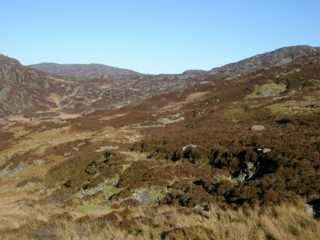 |
General view
Taken from near SH63652915 looking NNW towards smithy. There is a group of workings (mostly concealed by heather) to the right of the middle of the picture. The main line of workings (also concealed by heather) run from the ruined smithy(?) building visible in the centre of the picture upwards to the right and continue for some considerable distance. The summit at the right of the distant skyline is Rhinog Fawr. |
|
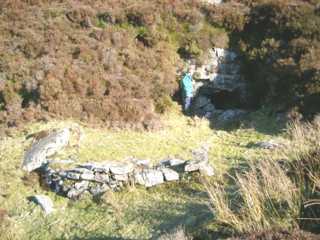 |
Dressing Floor and Adit Entrance
The adit entrance is in the patch of shadow to the right of the figure. Unlike many manganese mine ‘adits’, this adit has been driven through solid rock to reach the bed rather than being formed in the bed from walled-up waste. The adit is perhaps 3 m long and leads to an apparently large underground working, much of which has been filled to near roof level by waste. |
|
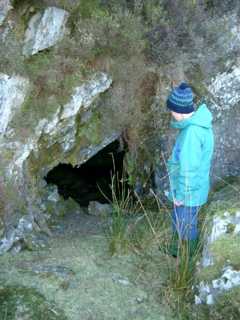 |
Entrance to underground working
The left wall of the entrance is formed from walled-up waste. |
|
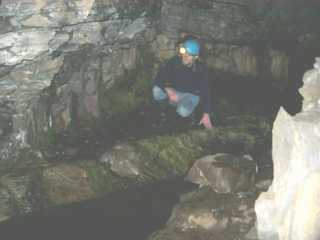 |
Underground working
Just inside the entrance shown in the picture above. The working is approximately 4 m long x 2 m wide by 1.5 m high. The water is perhaps .5 m depth at its deepest part. Note growth of lichen due to daylight from entrance (which is just out of sight behind rocks on right of picture). |
|
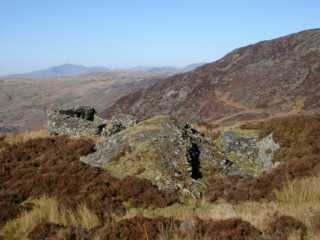 |
Working adjacent to smithy
Visible is part of a large opencut and a substantial tip associated with it. Beyond the tip at a lower level is a further tip, which was possibly fed by a tramway from the working. In the background is what is possibly a smithy building (see below). |
|
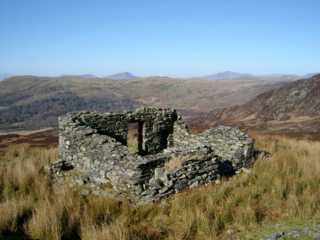 |
Smithy
Presumed smithy at SH63842921. Visible in the far distance are (from left to right) Mynydd Drws y Coed, Moel Hebog and Yr Wyddfa. |
|
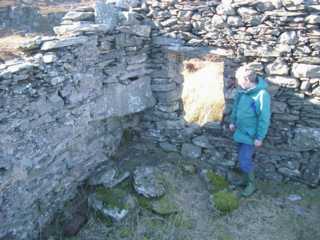 |
Smithy(?) Hearth
Hearth and flue in left-hand corner of building in picture above. This hearth is less built up than obvious smithy hearths at Egryn and Hendre and there is no sign of the stub walls found at those locations. Consequently, it is difficult to be certain that this was a smithy. To the left of the hearth on the ground (visible near bottom right of picture) is a cast iron artefact, purpose unknown. (See below for close-up.) |
|
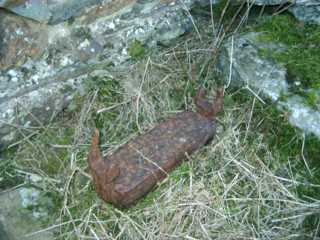 |
Artefact in Smithy
Detail of cast iron artefact visible in picture above. Purpose unknown. Possibly formed by casting the body around a wrought-iron forging. The elongated parts of the forks visible in the picture may have been threaded. It is possible that it was a weight on the compression arm of the air reservoir section of the smithy bellows, secured to the arm by straps across the tops of the forks retained by nuts. |